2. 云南农业大学资源与环境学院, 650201, 昆明;
3. 华能澜沧江水电有限公司, 650214, 昆明;
4. 云南农业大学水利学院, 650201, 昆明
中国水土保持科学  2024, Vol. 22 2024, Vol. 22  Issue (6): 86-95. DOI: 10.16843/j.sswc.2024030 Issue (6): 86-95. DOI: 10.16843/j.sswc.2024030 |
三江并流区位于云南省西北部,E 98°7′~100°19′、N 25°33′~29°16′之间,总面积约6万km2,是我国最大的世界自然遗产地,也是西南地区重要生态屏障的核心区;该区生态脆弱、岩质松软、岩石破碎,成土母质易于风化,是水土流失高发地区之一[1]。三江并流区内怒江、澜沧江、金沙江3条大河并行而流170多公里,水资源丰富,国家规划建设26座蓄水电站,总装机容量4万MW,接近2个三峡电站[2],目前除怒江外,澜沧江、金沙江上规划的电站已建成或正在建设。
水电站建成运行后,在库周形成大面域的消落带。消落带水位的涨落,导致很多原生植物难以存活,植物种群和群落数目减少,丰富度降低,土壤流失、岩石裸露[3],造成崩塌、滑坡、泥石流等严重的土壤侵蚀;消落带侵蚀产生的泥沙,淤损有效库容,导致发电机机组磨损、泄水闸门淤堵等影响安全发电和度汛的问题[4]。恢复水电站库周消落带植被、控制土壤侵蚀,对保障电站安全运行、保障三江并流区生态安全具有重要意义。
消落带适生植物的筛选和配置是消落带植被恢复的关键。国内外围绕三峡水库[5-6]、向家坝水库[7]、大宁水库[8]、乌东德水库[9]、南非西开普省伯格河沿岸[10]等开展适生植物的筛选和配置模式的研究,但针对三江并流区消落带适生植物的筛选和配置模式尚未见报道。位于澜沧江上游的黄登水电站,地处三江并流区的核心地带,消落带水位差达33 m。库区地势陡峭、河谷深切、基岩风化度高,水土流失严重,沿江88 km长度范围的库岸发育近60处活动性滑坡[11],超过怒江、澜沧江和金沙江干流流域滑坡总数的10%,是三江并流区沿江滑坡发育最频繁、最密集的区段,在三江并流区具有较强的代表性。在黄登水电站库周消落带开展适生植物筛选和配置研究,为该水电站库周消落带植被恢复提供依据,也为三江并流区消落带生态修复提供参考。
1 研究区概况黄登水电站坝址位于云南省兰坪县境内,库区向上延伸至维西县,2019年6月工程完建。黄登水电站蓄水前,区内土地利用方式有水田、旱地及荒地,荒地上有核桃(Juglans regia)等原生乔木以及狗牙根(Cynodon dactylon)、青蒿(Artemisia caruifolia)等原生草本。黄登水电站典型水文年水位变化见图 1,每年5—11月逐渐蓄水至最高水位1 619 m,11至翌年5月逐渐放水至最低水位1 586 m。
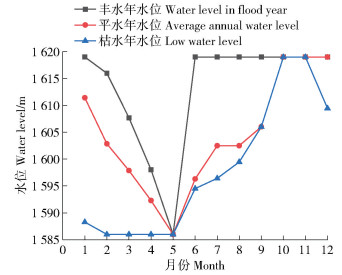
|
图 1 黄登水电站典型水文年水位变幅图 Fig. 1 Variation of water level in each typical hydrological year of Huangdeng Hydropower Station |
试验区位于维西县维登乡小庄村,为库尾左岸平缓开阔的消落带(E 99°10′29″、N 27°6′56″),属于亚热带与温带季风高原山地气候,年均气温14.9 ℃,年均降雨量938.6 mm,平均坡度为15°,土壤类型为淤积土。经测定土壤理化性质为:pH值为8.17,有机质质量分数为11.71 g/kg,全氮质量分数为0.87 g/kg,全磷质量分数为0.62 g/kg,全钾质量分数为21.14 g/kg。
2 材料与方法 2.1 供试植物消落带适生植物的筛选,主要考虑植物耐水淹、耐干旱、耐贫瘠的能力,参考前人研究成果[12-16],选择2种藻类、14种草本和4种乔木作为供试植物,具体为狐尾藻(Myriophyllum verticillatum)、黑藻(Hydrilla verticillata)、苦草(Vallisneria natans)、篦齿眼子菜(Stuckenia pectinata)、狗牙根、野古草(Arundinella hirta)、牛鞭草(Hemarthria sibirica)、香根草(Chrysopogon zizanioides)、芦苇(Phragmites australis)、千屈菜(Lythrum salicaria)、菖蒲(Acorus calamus)、凤仙花(Impatiens balsamina)、风车草(Cyperus involucratus)、美人蕉(Canna indica)、花叶芦竹(Arundo donax ‘Versicolor’)、泽泻(Alisma plantago-aquatica)、中山杉(Taxodium‘Zhongshanshan’)、枫杨(Pterocarya stenoptera)、竹柳(Salix hybrid)、池杉(Taxodium distichum var. imbricarium)。
2.2 试验区植物配置根据黄登水电站运行的各典型水文年水位变幅(图 1),试验设置Ⅰ区和Ⅱ区,Ⅱ区在Ⅰ区下游100 m处,其立地条件一致,属于重复区,每个试验区有4个高程梯度,每个高程梯度4个处理,其植物种类配置见表 1,Ⅰ区、Ⅱ区面积合计3 000 m2。
| 表 1 试验区植物配置 Tab. 1 Plant configuration in the experimental area |
植物种植时间为2019年5月1—15日。狐尾藻、黑藻、苦草、篦齿眼子菜扦插种植,株行距为0.3 m×0.3 m。狗牙根、野古草、牛鞭草、香根草播种密度为100 kg/hm2。泽泻、千屈菜、花叶芦竹、菖蒲、凤仙花、风车草、美人蕉和芦苇移栽种植,株行距为0.3 m×0.3 m,1 ∶1混栽。Ⅰ区中山杉、枫杨、竹柳、池杉各种植70、50、60、63株,Ⅱ区中山杉、枫杨、竹柳、池杉各种植70、57、60、60株,为带有30 cm×30 cm土球的一级壮苗,行间距为2×2 m,栽植前对4种苗木枝条进行修剪,以保证各树种的分枝情况基本一致。
2.3 观测指标及方法观测的指标为草本植物的株高、盖度和地上部分生物量,乔木的存活率、树高、冠幅、胸径。草本观测方法:在每个处理的不同高程分别选定具有代表性的植被,用1 m×1 m样方圈定,目测估算样方内的盖度,取样方内地上部分用烘干法测定生物量,株高用皮尺测定;每种植物3次重复。乔木观测方法:统计每种乔木存活株数计算存活率,每个处理按S型选定5株具有代表性的乔木作为监测株,挂好样标,用勃鲁莱式测高器测定监测样株的树高、用皮尺测定冠幅、用游标卡尺测定胸径。观测了5次,观测时间分别为:2020年3月6—7日、2020年11月18—21日、2021年5月7—9日、2022年9月3—4日、2023年10月3—4日。
数据使用Excel 2021和SPSS 20进行统计分析,通过Origin 2018进行绘图。
3 结果与分析 3.1 草本植物生长性状1 605~1 610 m范围内,第1次观测2个观测区均未找到所种的狐尾藻、黑藻、苦草、篦齿眼子菜4种植物,已全部死亡。1 610~1 615 m范围内,5次观测2个观测区均发现少量的狗牙根,由于数量较少,未作观测,其余植物未找到。1 615~1 618 m范围内,2个观测区,野古草、香根草、牛鞭草前3次观测时相继死亡,后2次观测仅见狗牙根,说明在1 615~1 618 m范围内4种植物中只有狗牙根能存活,其生长状况较好,最后1次观测时平均株高为8.95~17.68 cm,平均盖度为15%~30%,平均生物量为14.56~35.19 g/m2。1 618~1 620 m范围内,2个观测区,凤仙花、泽泻、千屈菜、牛鞭草和野古草在前3次观测时相继死亡,而芦苇、狗牙根、菖蒲、风车草、美人蕉、花叶芦竹、香根草7种植物5次均观测到,它们的生长性状如图 2所示。花叶芦竹的株高、盖度、生物量逐年增长,其他6种相对稳定。种植4年后,Ⅰ区和Ⅱ区的平均株高为花叶芦竹>芦苇、风车草、美人蕉>狗牙根、菖蒲、香根草,平均盖度为花叶芦竹、菖蒲>芦苇、风车草、美人蕉、狗牙根>香根草,平均生物量为花叶芦竹>芦苇、风车草、美人蕉>狗牙根、菖蒲、香根草;花叶芦竹明显优于其他6种,其平均株高、盖度、生物量分别为2.41 m、95%、1 247 g/m2。综合来看,花叶芦竹生长性状最好,香根草较差,其余5种居中。
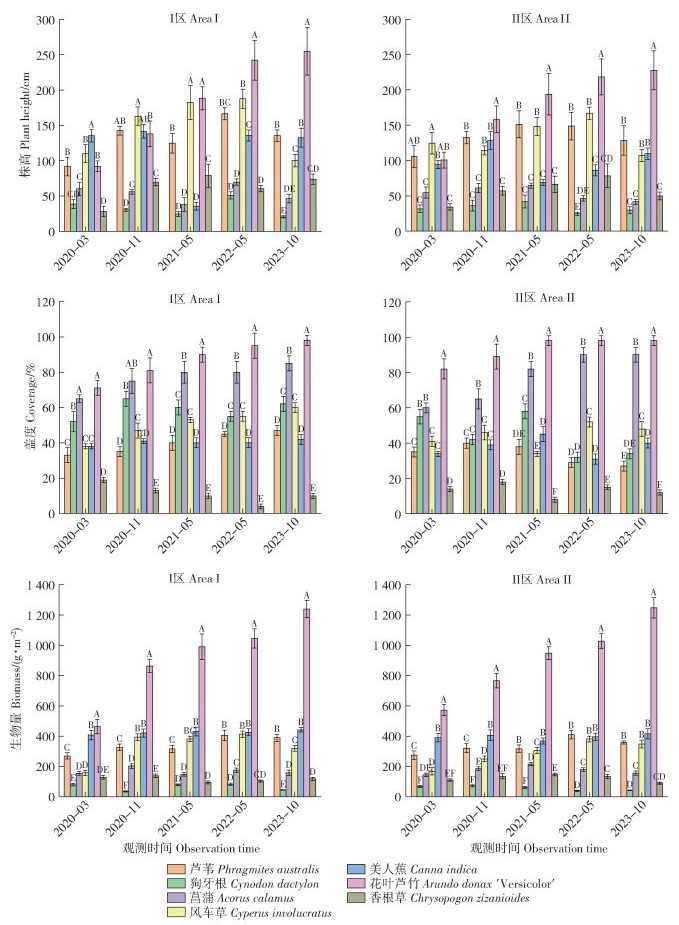
|
不同大写字母表示同一观测时间不同草本之间差异极显著,P < 0.01。 Different uppercase letters indicate significant differences between herbs at the same observation time, P < 0.01. 图 2 试验区1 618~1 620 m范围内草本植物生长性状 Fig. 2 Growth traits of herbaceous plant in the experimental area from 1 618-1 620 m |
存活率是植物对生长环境适应性最直接的体现,4种乔木的存活率见图 3。除竹柳外,其他3种乔木存活率逐年降低,到2023年10月第5次观测时,Ⅰ区中竹柳、池杉、枫杨、中山杉的存活率分别为100%、45%、40%、20%,Ⅱ区的存活率分别为100%、38.33%、33.33%、13.33%,平均成活率分别为100%、41.67%、36.67%、16.67%,竹柳适应性明显优于其他3种。
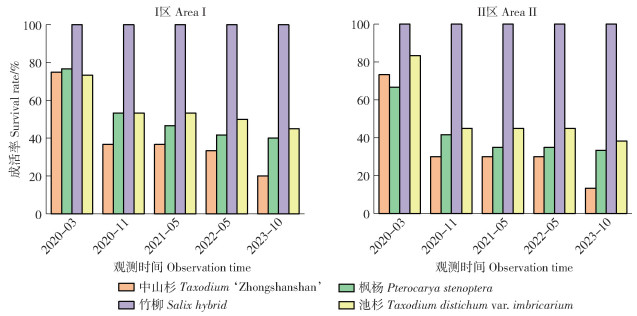
|
图 3 乔木存活率 Fig. 3 Survival rates of trees in the test area |
4种乔木的生长性状见图 4。2个观测区5次观测发现,竹柳、枫杨、池杉的树高、冠幅、胸径随时间均有不同程度的增长;中山杉的树高、冠幅出现小幅波动,主要是其有枯梢和枯枝现象。移栽4年后,2个观测区的平均树高表现为竹柳>池杉>枫杨>中山杉,平均冠幅表现为竹柳>枫杨>池杉>中山杉,平均胸径表现为竹柳>池杉>中山杉>枫杨,最后一次观测竹柳的平均树高为880.34 cm、平均冠幅为294.33 cm、平均胸径为12.99 cm,明显优于其它3种。总的来看,竹柳生长性状最好,池杉和枫杨次之,中山杉最差。
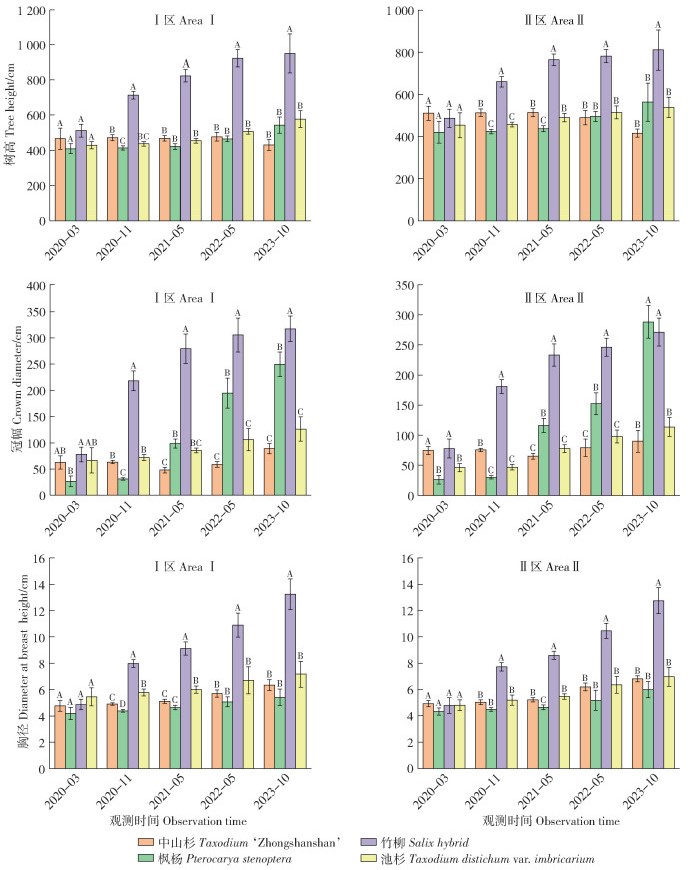
|
不同大写字母表示同一次观测时间不同乔木之间差异极显著,P < 0.01。 Different uppercase letters indicate significant differences among trees at the same observation time, P < 0.01. 图 4 试验区乔木不同时期生长性状 Fig. 4 Growth characteristics of trees in different stages in the experimental area |
对比2个观测区植物的生长性状,草本除花叶芦竹外,其余6种植物的生长性状Ⅱ区没有Ⅰ区好;乔木成活率除竹柳的外,其余3种植物Ⅱ区没有Ⅰ区高,生长性状Ⅱ区也没有Ⅰ区好,其原因在于Ⅱ区淤泥堆积比Ⅰ区严重,不利于植物的生长。
3.3 黄登水电站库周消落带生态修复植物配置模式消落带植被配置一般采用乔、灌、草搭配,消落带中下部配置耐淹能力较强的多年生草本和1年生草本植物,消落带上部则配置兼具耐淹及耐旱能力的灌木和乔木[8]。根据黄登水电站典型水文年水位变幅,结合试验观测,提出澜沧江黄登水电站库周消落带生态修复植物配置模式。
1) 1 586~1 605 m高程区域,平水年淹水时间在8个月左右,绝大部分陆生植物难以忍受8个月的水淹,而沉水植物在枯水季极易干死,且大部分地区地形陡峭、基岩裸露,不建议种植植物。
2) 1 605~1 615 m高程区域,平水年淹水时间约为4个月,狗牙根可以存活,建议种植。
3) 1 615~1 618 m高程区域,平水年淹水时间在3个月左右,建议种植竹柳、桑树(Morus alba)和狗牙根。
4) 1 618~1 620 m高程区域,平水年淹水时间在3个月左右,建议种植花叶芦竹、菖蒲、风车草、美人蕉、芦苇、狗牙根、香根草,并将景观效果好的花叶芦竹、风车草、美人蕉配置在最外侧。
植物种植4年后,生长性状良好,景观效果佳(图 5)。
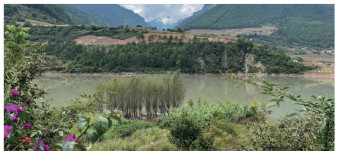
|
图 5 人工种植4年后试验区一角 Fig. 5 A corner of the experimental area after 4 years of artificial planting |
狗牙根在1 610~1 618 m高程范围内能存活,在1 618~1 620 m高程范围内生长良好,其适生性最好。研究[17]表明,狗牙根具有高水淹耐受能力和出露期的快速恢复能力,能在消落带高强度水淹环境中形成稳定群落;浅水区的狗牙根种群应对水陆生境变化特有的适应策略是加速伸长生长,增加茎生物量分配;深水区的策略是增加分枝节间数量、分枝数量和叶生物量分配[18],但是如果泥沙掩埋过深狗牙根出苗率会显著降低,光合作用能力也显著降低[19],导致其在过深的水位下亦难以存活。
在1 618~1 620 m高程内,以花叶芦竹的株高、生物量、盖度最大,生长性状最好,且具有一定耐旱性[20],其根系发达、固土能力强[21],是该区域植被恢复优选草本。此外,香根草虽然能够成活,但其株高、盖度、生物量均较小,这可能是其在种间竞争中处于劣势。
4.2 乔木植物适应性竹柳移栽4年后,在2个观测区成活率均为100%,表现出很强的适应性。竹柳淹水后树干在水面处长出浓密的呼吸根(图 6a)漂浮在水面上,能进行根呼吸,保证了竹柳的生长,而其他树种水淹一个月即出现枝叶枯萎等厌氧症状[16, 22],这是竹柳在消落带适应性明显优于其他乔木的主要原因。此外,竹柳不具入侵性,还具有较强的根系发育能力和固土能力[23],是消落带植被恢复的优选树种。研究表明[24],半淹水条件在一定程度上促进竹柳地茎的生长,而全淹水条件下对其有显著的抑制作用,因此在消落带配置竹柳,应以不没顶淹水为宜。
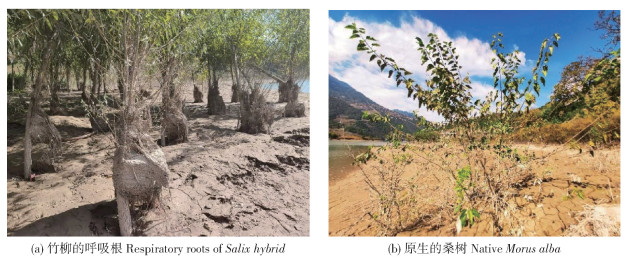
|
图 6 试验区竹柳的呼吸根和原生的桑树 Fig. 6 Respiratory roots of Salix hybrid and native Morus alba in the experimental area |
移栽4年后中山杉2个观测区的平均成活率仅为16.79%,在4种乔木中最低。中山杉耐淹能力较强,但耐旱能力不如桑树、水杉等[25]。在2~6月,库区降雨少、气侯干旱,干热河谷特点突出,该时段平水年库水位在1 592~1 603 m高程内运行,种植在1 615~1 618 m高程内的中山杉离水较远,水分供应困难,受到干旱胁迫,导致成活率较低。
在试验区现场调查中,在1 617 m左右高程处发现原有2棵原生桑树(图 6b),树高3.28 m、有30余分枝,在淹水深度为1.87 m的情况下,生长状态良好,结合文献[26]的研究结果,可认为桑树也是该区消落带生态恢复的适宜树种。
5 结论1) 狐尾藻、黑藻、苦草、篦齿眼子菜在1 605~ 1 610 m高程范围难以存活;狗牙根在1 610~1 618 m高程范围内能存活;芦苇、菖蒲、风车草、美人蕉、花叶芦竹、香根草7种草本在1 618~1 620 m高程范围内长势良好,以花叶芦竹的株高、生物量、盖度最大。
2) 1 615~1 618 m高程内,竹柳、池杉、枫杨、中山杉的存活率依次为100%、41.67%、36.67%、16.67%,适生性依次为竹柳>池杉>枫杨>中山杉,竹柳明显优于其他3种乔木。
3) 黄登水电站库周消落带生态修复植物配置模式为:1 586~1 605 m高程区域,不建议种植植物;1 605~1 615 m高程区域,建议种植狗牙根;1 615~1 618 m高程区域,建议种植竹柳、桑树和狗牙根;1 618~1 620 m高程区域,建议种植花叶芦竹、风车草、美人蕉、菖蒲、芦苇、香根草、狗牙根,并将景观效果好的花叶芦竹、风车草、美人蕉配置在最外侧。
4) 所选适生植物在黄登水电站库周消落带种植4年后,生长性状良好且有较好的景观效果,该配置模式可在三江并流区消落带推广应用。
| [1] |
万晔, 司徒群, 李子海. 滇西北地理环境特征与区域水土流失相互作用机制研究[J]. 水土保持通报, 2003, 23(5): 1. WAN Ye, SITU Qun, LI Zihai. Relationship between regional geographic environment characteristics andsoil and water loss of Northwest Yunnan province[J]. Bulletin of Soil and Water Conservation, 2003, 23(5): 1. |
| [2] |
李俊君, 余静丹. 三江并流地区水利水电发展与生态和谐研究[J]. 中国水运, 2012, 12(8): 136. LI Junjun, YU Jingdan. Study on water conservancy and hydropower development and ecological harmony in the area of three parallel rivers[J]. China Water Transport, 2012, 12(8): 136. |
| [3] |
赵洋, 饶良懿, 周紫璇. 中国水库消落带生物治理研究综述[J]. 环境科学与技术, 2016, 39(12): 71. ZHAO Yang, RAO Liangyi, ZHOU Zixuan. Review on the bioremediation practices of reservoir water level fluctuating zone in China[J]. Environmental Science & Technology, 2016, 39(12): 71. |
| [4] |
李贵生, 胡建成. 刘家峡水电站坝前和洮河库区泥沙淤积状况及应采取的对策[J]. 人民黄河, 2001, 23(7): 27. LI Guisheng, HU Jiancheng. Sedimentation situation in front of Liujiaxia Hydropower Station Dam and Tao River Reservoir area and the necessary corresponding treatments[J]. Yellow River, 2001, 23(7): 27. |
| [5] |
钟彦, 唐恒, 田辉, 等. 三峡库区(万州段)消落带4种乡土草本植物的水淹胁迫响应[J]. 中国水土保持科学, 2021, 19(6): 115. ZHONG Yan, TANG Heng, TIAN Hui, et al. Submerging stress response mechanism of 4 local herbaceous plants in the water-level-fluctuating zone of the Wanzhou section of the Three Gorges Reservoir Area[J]. Science of Soil and Water Conservation, 2021, 19(6): 115. DOI:10.16843/j.sswc.2021.06.015 |
| [6] |
HU Xin, ARIF M, DING Dongdong, et al. Invasive plants and species richness impact litter decomposition in riparian zones[J]. Frontiers in Plant Science, 2022, 13: 955656. |
| [7] |
孙龙, 卢涛, 孙涛, 等. 金沙江下游典型库区消落带植被恢复模式[J]. 生态学报, 2023, 43(2): 826. SUN Long, LU Tao, SUN Tao, et al. Vegetation restoration pattern of water-level-fluctuating zone in two cascaded reservoirs in the lower Jinsha river[J]. Acta Ecologica Sinica, 2023, 43(2): 826. |
| [8] |
张義, 于一雷, 李胜男, 等. 南水北调北京段大宁水库消落带植被分布特征及多样性[J]. 水生态学杂志, 2021, 42(4): 40. ZHANG Yi, YU Yilei, LI Shengnan, et al. Vegetation distribution and diversity in the water-level-fluctuation zone of Daning Reservoir, Beijing Section, Middle Route of the South-to-North Water Diversion[J]. Journal of Hydroecology, 2021, 42(4): 40. |
| [9] |
周火明, 于江, 万丹, 等. 乌东德库区消落带生态修复植物遴选与配置[J]. 长江科学院院报, 2022, 39(2): 50. ZHOU Huoming, YU Jiang, WAN Dan, et al. Plant screening and vegetation arrangement for ecological restoration in water-level-fluctuating zone of Wudongde Reservoir[J]. Journal of Yangtze River Scientific Research Institute, 2022, 39(2): 50. |
| [10] |
RUWANZA S, GAERTNER M, ESLER K J, et al. The effectiveness of active and passive restoration on recovery of indigenous vegetation in riparian zones in the western Cape, South Africa: A preliminary assessment[J]. South African Journal of Botany, 2013, 88: 132. |
| [11] |
姚鑫, 邓建辉, 刘星洪, 等. 青藏高原泛三江并流区活动性滑坡InSAR初步识别与发育规律分析[J]. 工程科学与技术, 2020, 52(5): 16. YAO Xin, DENG Jianhui, LIU Xinghong, et al. Primary recognition of active landslides and development rule analysis for pan three-river-parallel territory of Tibet Plateau[J]. Advanced Engineering Sciences, 2020, 52(5): 16. |
| [12] |
高汾, 张毅敏, 杨飞, 等. 水位抬升对4种沉水植物生长及光合特性的影响[J]. 生态与农村环境学报, 2017, 33(4): 341. GAO Fen, ZHANG Yimin, YANG Fei, et al. Growth and photosynthetic fluorescence characteristics responses of four submersed Macrophytes to rising water level[J]. Journal of Ecology and Rural Environment, 2017, 33(4): 341. |
| [13] |
黄世友, 马立辉, 方文, 等. 三峡库区消落带植被重建与生态修复技术研究[J]. 西南林业大学学报(自然科学), 2013, 33(3): 74. HUANG Shiyou, MA Lihui, FANG Wen, et al. Study on the reconstruction and ecological restoration techniques of vegetation in hydro-fluctuation belt of the Three Gorge Reservoir[J]. Journal of Southwest Forestry University(Natural Sciences), 2013, 33(3): 74. |
| [14] |
YE Xiaoqi, ZENG Bo. Survival and carbohydrate storage in two tolerant species exposed to prolonged flooding in the three gorges reservoir region[J]. Acta Hydrobiologica Sinica, 2013, 37(3): 450. |
| [15] |
郭泉水, 洪明, 裴顺祥, 等. 香根草形态性状和光合特性对三峡库区消落带水陆生境变化的响应[J]. 西北植物学报, 2012, 32(11): 2328. GUO Quanshui, HONG Ming, PEI Shunxiang, et al. Form traits and photosynthesis characteristics of Vetiveria zizanioides response to flooding-drying habitat changes in the hydro-fluctuation belts of the Three Gorges Reservoir[J]. Acta Botanica Boreali-Occidentalia Sinica, 2012, 32(11): 2328. |
| [16] |
熊兴政. 水淹对三峡库区消落带三种木本植物生长及光合作用的影响[D]. 重庆: 西南大学, 2016: 19. XIONG Xingzheng. Effects of water flooding on the three species of woody plants growth and photosynthesis in hydro-fluctuation belt of the Three Gorges Reservoir area[D]. Chongqing: Southwest University, 2016: 19. |
| [17] |
李强, 丁武泉, 王书敏, 等. 三峡库区多年高水位运行对消落带狗牙根生长恢复的影响[J]. 生态学报, 2020, 40(3): 241. LI Qiang, DING Wuquan, WANG Shumin, et al. Influence of multi-year high water level running on growth recovery of Cynodon dactylon population in water-level-fluctuating zone of the Three Gorges Reservoir[J]. Acta Ecologica Sinica, 2020, 40(3): 241. |
| [18] |
洪明, 郭泉水, 聂必红, 等. 三峡库区消落带狗牙根种群对水陆生境变化的响应[J]. 应用生态学报, 2011, 22(11): 2829. HONG Ming, GUO Quanshui, NIE Bihong, et al. Responses of Cynodon dactylon population in hydro-fluctuation belt of Three Gorges Reservoir area to flooding-drying habitat change[J]. Chinese Journal of Applied Ecology, 2011, 22(11): 2829. |
| [19] |
李强. 泥沙掩埋和干旱对三峡库区消落带狗牙根生长恢复的影响[J]. 生态学报, 2016, 36(1): 200. LI Qiang. Influence of sand burial and drought on growth recovery of Cynodon dactylon in a water-level-fluctuating zone of the Three Gorges Reservoir[J]. Acta Ecologica Sinica, 2016, 36(1): 200. |
| [20] |
许令明, 曹昀, 汤思文, 等. 干旱胁迫及复水对花叶芦竹生理特性的影响[J]. 中国水土保持科学, 2020, 18(3): 59. XU Lingming, CAO Yun, TANG Siwen, et al. Effects of drought stress and rewatering on physiological characteristics of Arundo donax var.versicolor[J]. Science of Soil and Water Conservation, 2020, 18(3): 59. DOI:10.16843/j.sswc.2020.03.007 |
| [21] |
黄广杰, 段青松, 李建兴, 等. 三江并流区水库消落带5种草本根系形态及抗拉特性[J]. 水土保持研究, 2022, 29(3): 389. HUANG Guangjie, DUAN Qingsong, LI Jianxing, et al. Root morphology and tensile characteristics of five kinds of Herbsin Reservoir fluctuating zone of Three Parallel River[J]. Research of Soil and Water Conservation, 2022, 29(3): 389. |
| [22] |
NAKAMURA T, NAKAMURA M. Root respiratory costs of ion uptake, root growth, and root maintenance in wetland plants: Efficiency and strategy of O2 use for adaptation to hypoxia[J]. Oecologia, 2016, 182: 667. |
| [23] |
黄广杰. 黄登电站库区消落带4种乔木生长性状及根系生物力学性能研究[D]. 昆明: 云南农业大学, 2022: 30. HUANG Guanjie. Study on growth and root biomechanical properties of four tree species in the water level fluctuating zone of reservoir area in Huangdeng Hydropower Station[D]. Kuming: Yunnan Agricultural University, 2022: 30. |
| [24] |
甘丽萍, 王晓念, 曹煦悦, 等. 水淹胁迫对竹柳幼苗形态结构和生理特征的影响[J]. 水生态学杂志, 2022, 43(6): 102. GAN Liping, WANG Xiaonian, CAO Xuyue, et al. Effects of flooding on the morphology and physiology of Salix hybrid[J]. Journal of Hydroecology, 2022, 43(6): 102. |
| [25] |
陈珂. 四种木本植物对冬涝夏旱的适应性比较研究[D]. 重庆: 西南大学, 2018: 33. CHCN Ke. Comparative evaluation of adaptability of four woody paints against winter flooding and summer drought[D]. Chongqing: Southwest University, 2018: 33. |
| [26] |
甘丽萍, 杨玲, 李豪, 等. 三峡库区消落带狗牙根与桑树淹没后的恢复机制[J]. 中国水土保持科学, 2020, 18(5): 60. GAN Liping, YANG Ling, LI Hao, et al. Recovery mechanism of Cynodon dactylon and Morus alba after reemergence in the water-level-fluctuating zone of the Three Gorges Reservoir[J]. Science of Soil and Water Conservation, 2020, 18(5): 60. DOI:10.16843/j.sswc.2020.05.008 |